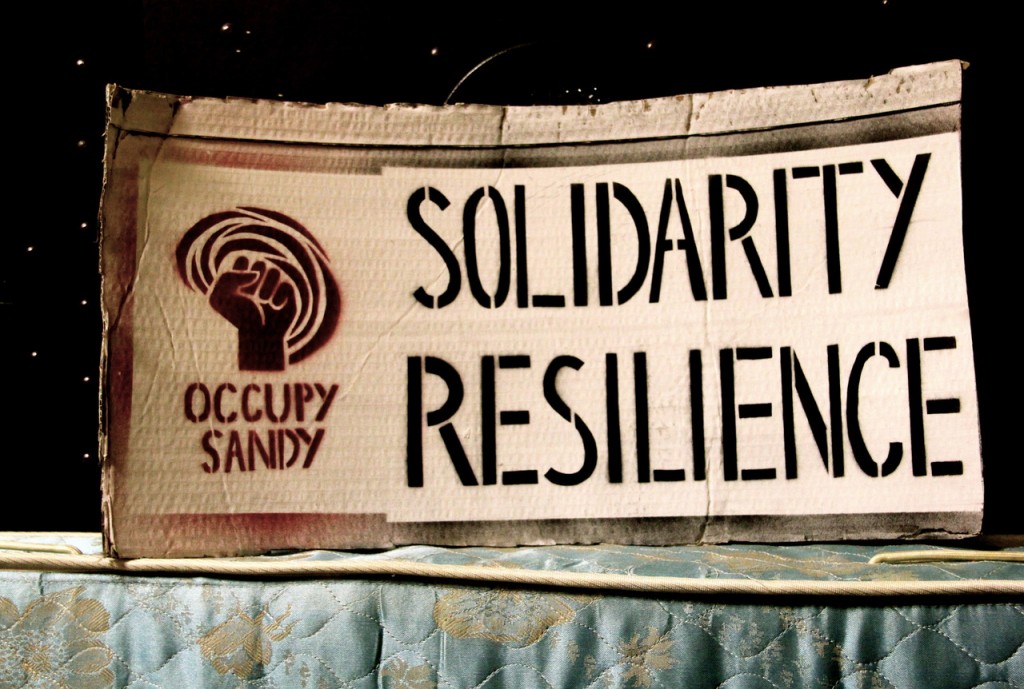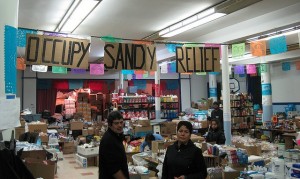
It was Martin Luther King, Jr.’s birthday, and the sound of pounding drums mingled with subway steel rattling underground, sending a hot pulse through the high-arched edifice of a humble house of worship in Sunset Park, Brooklyn. As Nina Simone sang in her blue soliloquy to the slain civil rights leader, “The king of love is dead.” But here, in St. Jacobi Lutheran Church, one could feel King’s heart beat on.
Although you wouldn’t know by the look of the half-full pews last week, thousands of people have passed through this church in the last few months. Under the auspices of Occupy Sandy, volunteers gathered to deliver millions of pounds worth of casseroles, soups, chiles and lasagna, as well as clothing and medicine, to those left without a roof over their heads. Now, three months after Superstorm Sandy, the recovery has entered a new but no less trying phase.
“The holy month of November made this church holy,” said Pastor Juan Carlos Ruiz, recalling for the multiracial congregation the beacon of hope that the church became after October 30, when Sandy made landfall and ripped through the social fabric of many New York communities. It wasn’t the church’s iconography or a tax-exempt status that sanctified St. Jacobi, but rather the struggle for social justice — embodied by King (not to mention Christ) — that continues within its walls.
Ruiz first put on a frock when he was 17 years old in order to sneak into a jail in Paterson, N.J., and expose inmate abuse. In a precursor to later war-on-terror scandals, corrections officers were using German shepherds to wield power over the prison’s Muslim population. Ruiz helped uncover that practice of torture. And now he’s still fighting oppression, only these days the robes are real.
“What is your struggle?” Ruiz asked, inviting the congregation to call out their answers. Responses popcorned from the wooden rows in English and Spanish — housing, healthcare, immigration, racial equality, worker justice — each a battle against the little Sandys of daily life experienced by the poor and working class of New York.
“The storm evidenced the brewing, lived-in storms we’ve been dealing with,” Ruiz told me later. Within Sandy-struck neighborhoods, “there is not much of an infrastructure or a safety net. You name it, we got it. With the storm, this neglect has intensified.”

Days, weeks and now months have passed, and many are still in desperate need of resources that are at the disposal of city, state and federal agencies, as well as large NGOs such as the Red Cross. In contrast to the slothful official response, Ruiz and his allies from the Occupy movement launched a relief drive and opened up St. Jacobi for donations. Before he went to bed the night following the storm, Ruiz found three bags of groceries and two gallons of water on the church’s doorstep. “I thought, ‘Okay, this is it.’” But when he went to open up the church the next day, he found hundreds of people waiting to come inside, bags of food and supplies in their hands.
“From day one, Occupy put down its principles of solidarity and mutual aid,” he said. “And that has made all the difference because it has cut through all the bureaucratic and corporate tape. Otherwise we would still be waiting for help.”
Occupy and allies continue to perform day-to-day relief functions and have begun to institute long-term recovery projects in affected areas. Meanwhile, a new storm has begun to gather. Fifty billion dollars from the federal government is expected to begin rolling into disaster areas in the coming months. Funds will be filtered through what Eddie Bautista, of the New York Environmental Justice Alliance (NYEJA), calls the “Disaster Industrial Complex” or “D.I.C.” — an intricate network of government agencies and contractors. The groups on the ground that stepped up while these agencies that collect our tax dollars slept in are pushing for a recovery that is bottom-up, not top-down.
Bautista hails from Red Hook, Brooklyn — a mostly black and Latino neighborhood sandwiched between abandoned industrial docks and the Gowanus Canal, a federally designated Superfund site. On October 29, the canal’s toxic waters flooded into the adjacent housing projects. Not long after the storm, Bautista toured the area with the Environmental Protection Agency, urging officials to conduct tests in order to determine what contamination ensued from the flooding. No samples were taken, and environmentalists fear they’ll have to wait for the effects of flooding to reveal themselves in the city’s underfunded hospitals and medical clinics.
According to climate scientists, Sandy’s siblings might not hit shore at a greater frequency, but they’ll likely be more severe when they do — a warning that has led the NYEJA to push for the funding of climate adaptation and mitigation. “To be fair,” said Bautista, Mayor Michael Bloomberg’s administration has been doing some hazard mitigation studies. “But it’s mostly focused on Lower Manhattan and the Financial District. We’ve been trying to get them to look at industrial zones, but it’s not their priority.” Greening waterfronts in New York has generally meant altering their zoning designation from industrial to residential. Due to “gentrification pressures” that accompany waterfront redevelopment, pushing for such policies, said Bautista, would “basically be like cutting our own throats.”
“We need to make sure we’re at the table, not on the menu,” said Bautista’s colleague, Elizabeth Yeampierre. That means ensuring money goes toward preparing for future climate chaos and projects addressing the ecological and economic toll Sandy has borne on costal communities. According to Bautista and Yeampierre, that process should involve local residents, or else neighborhoods could get carved up.
After 9/11, New York’s governor at the time, George Pataki, and the city’s then-mayor, Rudolph Giuliani, formed the Lower Manhattan Development Corporation — a public-private entity designed to allocate federal disaster funds. Federally required public hearings were waved by President Bush and the bulk of funds meant to create jobs for low income New Yorkers went to Wall Street, including $23 million to Goldman Sachs. If the official response so far is any indication, we can expect more of the same in Sandy’s wake. The Federal Emergency Management Agency and the Red Cross have been seeking on-the-ground intel from Occupiers. Yet organizers I spoke with said they haven’t been contacted by Obama’s recently created Rebuilding Task Force.
In stark contrast to the trickle-down recovery approach, Occupy Sandy and allies are launching both immediate and long-term grassroots-based recovery initiatives.
“What’s next for Occupy Sandy?” asked Diego Ibanez, who helped establish the initial recovery hub at St. Jacobi and has been coordinating rebuilding in Rockaway, Queens. “The answer is becoming more and more what’s next for the hurricane recovery.” He sees Occupy Sandy not so much as the main character in the recovery, but as a resource for sharing skills and lending power that neighborhoods grappling with Sandy’s aftermath can utilize to create change.
One pressing problem that activists and Sandy survivors say must be addressed is mold. An estimated 70,000 to 80,000 homes suffered water damage from Sandy, and thousands remain either displaced or living in fungi-infested buildings. Occupy Sandy has been doing its best to cleanse neighborhoods of the bacteria, but emergency-response dollars needed to launch a large-scale remediation campaign are locked in federal coffers waiting for Mayor Bloomberg to request the funds.
Citywide protests last month from Sandy survivors set a January 1 cutoff date for the Bloomberg administration to safely move people back in, but the deadline has come and passed unheeded. Laborers Local 78, in coalition with Alliance for a Just Rebuilding, are calling for that cash to be released and put toward training Sandy survivors in remediation. They’ve outlined a plan that would both get people back in their homes and provide a source of employment for those in disaster areas, many of whom were laid off after being unable to clock in due to Sandy.
Others on the ground aren’t waiting for dollars from above. While a far cry from the billions at the disposal of the federal government, Occupy Sandy has pulled in hundreds of thousands of dollars’ worth of donations and is asking communities hit by the storm how they want to spend the money. Several businesses decimated by Sandy are being rebuilt as worker-run enterprises, including a bakery, a restaurant and a taxi co-op. Multiple day laborers’ collectives have also been initiated by Occupy allies. “It’s about community empowerment,” Ibanez said.
This weekend, Occupy Sandy will be hosting a rebuilding summit to strategize about ways to further harness that community power amassed in the struggle for survival.
“Right now in our midst we have people putting up a fight, linking arms in struggle,” Ruiz said in his Martin Luther King Day sermon. There are people among us who, like King, are battling “for what is right, for what is just.” Rising from their seats, the congregation repeats after him, “Mi lucha es tu lucha” – my struggle is your struggle.

How did you use social media during Superstorm Sandy? Univ. researchers want to know. Please take survey http://svy.mk/119rZec
This isn’t exactly social media, but it’s possibly more interesting — an example of how open source database software is being employed to address logistical tasks.
http://vitamindwb.com/?p=119